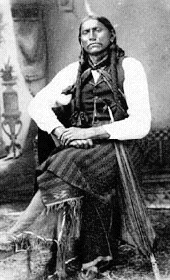
opens in new window
Quannah
Parker
1854-1911
"The
Tonkawa killed him - it make my heart hot.
I want my people follow after white way. Some white people do that,
too."

1854-1911
"The
Tonkawa killed him - it make my heart hot.
I want my people follow after white way. Some white people do that,
too."
Comanche leader; born at Cedar Lake, Texas. He was the son of a
Comanche chief and Cynthia Ann Parker, a captive white woman (taken
back by whites in 1860). He grew up to become a bold warrior and in
1867 was made war chief of the Kwahadi Comanche of the Staked Plains.
For the next eight years he led an alliance of various tribes in raids
against frontier settlements in Texas. After finally surrendering in
1875, he quickly accommodated himself to the white culture by learning
Spanish and English, adopting new agricultural methods, and promoting
education for his fellow Indians.
He himself prospered as both a farmer and the managing agent for
business deals between whites and Indian tribes - he was reputed in
later years to be the wealthiest Native American in North America - but
he also created wealth for fellow Indians by getting them to lease
surplus tribal lands to white cattlemen. In 1886 he became a judge of
the Court of Indian Affairs; by 1890 he was principal chief of all
Comanche bands; he was also a major figure in the peyote religion. He
rode beside Geronimo in the inaugural parade of President Theodore
Roosevelt (1905).
Quanah Parker's mother, Cynthia Ann Parker (born ca. 1827), was a member of the large Parker frontier family that settled in east Texas in the 1830s. She was captured in 1836 (at age nine) by Comanches during the raid of Fort Parker near present-day Groesbeck, Texas. Given the Indian name Nadua (Someone Found), she was adopted into the Nocona band of Comanches. Assimilated into the Comanche, Cynthia Ann Parker later married the warrior Peta Nocona, (also known as Noconie, Tah-con-ne-ah-pe-ah, or Nocona). His father was the renowned chief Iron Jacket, famous among the Comanche for wearing a Spanish coat of mail.
Nadua
and Nocona's first child was Quanah (Fragrance), born in the Wichita
Mountains of southwestern Oklahoma. Biographer Bill Neeley cites a
letter Quanah wrote late in life to his friend, rancher Charles
Goodnight, in which Quanah stated, “From the best information I have, I
was born about 1850 on Elk Creek just below the Wichita Mountains.”[2]
Author S.C. Gwynne supports the Oklahoma claim in his 2010 book, Empire
of the Summer Moon: Quanah Parker and the Rise and Fall of the
Comanches, the Most Powerful Indian Tribe in American History.
However, another account disputes the birthplace, contending that in
1911 Parker was seen traveling by automobile near Lubbock, Texas,
telling observers he was going to visit what he understood to be his
birthplace at Laguna Sabinas (Cedar Lake) in Gaines County, Texas.
Nadua and Nocona also had another son, Pecos, and a daughter, Topsana
(Prairie Flower). In December 1860, Nadua (Cynthia Ann) and Topsana
were captured in the battle of Pease River, which actually took place
along Mule Creek. American forces were led by Sgt. John Spangler, who
commanded Company H of the U.S. 2nd Cavalry, and Texas Rangers under
Lawrence Sullivan Ross (better known in Texas history as Sul Ross).
Quanah, his brother Pecos, and his father Peta Nocona were almost
certainly not at Mule Creek. However, in an effort to further his
political career, Sul Ross later fabricated a story wherein he claimed
to have killed Peta Nocona at Pease River. Ross would later become a
Texas state senator, and eventually governor.
Meanwhile, Nadua (Cynthia Ann) and her daughter Topsana were reunited
with her white family, but after having made her life 24 years with the
Comanche, she wanted to return to them and her sons. However, Topsana
died of an illness in 1863. Cynthia Ann Parker died in 1870.

|
|
![]() Return to
Indigenous Peoples' Literature
Return to
Indigenous Peoples' Literature
Compiled by: Glenn Welker
Copyright © 1993-2013
This page last updated 12/09/2013 20:25:10
This site has been accessed over 10,000,000 times since February 8,
1996.